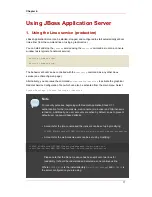
export JAVA_HOME=/usr/lib/jvm/java
where the value you give for
JAVA_HOME
is the location of your installed Java VM.
5. Running multiple instances of JBoss Application
Server
Note
Please note that automated updating of instances created using methods below
is not supported. If you create custom instances, you will manually have to port
files / changes from a new update to that instance.
The description here is restricted to running multiple instances of the JBoss Application Server
Linux service. Running multiple instances with
run.sh
is already described elsewhere in the
JBoss Application Server documentation.
You can administer multiple SysV services that run JBoss Application Server by creating
additional service scripts. The process basically consists of:
• creating a link with the new service name to the original
jbossas
init script in
/etc/init.d
• copying the
jbossas
file in
/etc/sysconfig
to one with the new service name (the init script
and the configuration file names must match)
• making the desired configuration changes making sure:
• port conflicts are avoided
• a different log file is specified
Note
The original init script log files are created under
/var/log/jbossas
in
directories that correspond to the configuration used (like 'default') with the usual
server.log
name. For instance:
/var/log/jbossas/default/server.log
In general, each log file is created by the SysV script as
/var/log/service-name/$JBOSSCONF/server.log
Running multiple instances of JBoss
15
Содержание APPLICATION STACK 2.0 RELEASE
Страница 1: ...Red Hat Application Stack V 2 0 Release Notes 2 0 ISBN N A Publication date ...
Страница 2: ...Red Hat Application Stack V 2 ...
Страница 3: ...Red Hat Application Stack V 2 0 Release Notes Copyright 2007 Red Hat Inc ...
Страница 4: ...Red Hat Application Stack V 2 ...
Страница 6: ...vi ...
Страница 8: ...2 ...
Страница 12: ...6 ...
Страница 26: ...20 ...






































